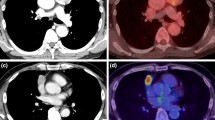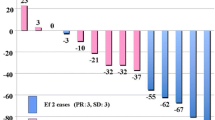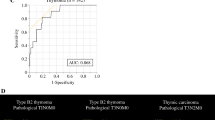Abstract
Objectives
18F-fluorodeoxyglucose positron emission tomography (FDG-PET) plays an important role in many oncological settings. In this study, we assessed the utility of 18F-FDG-PET for predicting the histological classification, stage and survival of thymic epithelial tumors.
Methods
We retrospectively analyzed 37 patients with thymic epithelial tumors who underwent PET before surgical resection and investigated the relationship between the maximum of standardized uptake value (SUVmax) of each tumor and the WHO classification, recurrence-free survival, and tumor-related gene expressions.
Results
The study included 15 males and 22 females, ranging in age from 22 to 81 years (mean 64 years). The tumor histology of 31 tumors was thymoma and that of the remaining tumors was thymic carcinoma. The Masaoka tumor stage was as follows: stage I in 18, II in 9, III in 5 and IV in 5 patients. The patients were divided into three groups according to a simplified histologic classification: low-risk thymoma (types A, AB and B1, n = 21), high-risk thymoma (types B2 and B3, n = 10) and thymic carcinoma (n = 6). The SUVmax of low-risk group (SUVmax ≤4.27) was significantly lower than that of high-risk group (p = 0.0114) and that of thymic carcinomas (SUVmax >4.27) was also significantly higher than that of thymomas (p < 0.0001). The group of high SUVmax (SUVmax >4.27) had significantly inferior recurrence-free survival to that of less value (SUVmax ≤4.27) (p = 0.0009). The SUVmax were not correlated with tumor-related gene expressions.
Conclusion
The SUVmax of 18F-FDG-PET reflects WHO classification of thymic epithelial tumors. High SUVmax predicts lower recurrence-free survival of the tumors.




Similar content being viewed by others
References
Okumura M, Miyoshi S, Fujii Y, et al. Clinical and functional significance of WHO classification on human thymic epithelial neoplasms: a study of 146 consecutive tumors. Am J Surg Pathol. 2001;25:103–10.
Okumura M, Ohta M, Tateyama H, et al. The World Health Organization histologic classification system reflects the oncologic behavior of thymoma: a clinical study of 273 patients. Cancer. 2002;94:624–32.
Fang W, Chen W, Chen G, et al. Surgical management of thymic epithelial tumors: a retrospective review of 204 cases. Ann Thorac Surg. 2005;80:2002–7.
Kumar A, Regmi SK, Dutta R, et al. Characterization of thymic masses using 18F-FDG PET-CT. Ann Nucl Med. 2009;23:569–77.
Benveniste MF, Moran CA, Mawlawi O, et al. FDG PET-CT aids in the preoperative assessment of patients with newly diagnosed thymic epithelial malignancies. J Thorac Oncol. 2013;40:1595–601.
Sung Y, Lee K, Kim B, et al. 18F-FDG PET/CT of thymic epithelial tumors: usefulness for distinguishing and staging tumor subgroups. J Nucl Med. 2006;47:1628–34.
Müller-Hermelink HK, Möller P, Engel P, et al. Tumours of the thymus. In: Travis WD, Bramblla E, Müller-Hermelink HK, et al. editors. Pathology and genetics of tumours of the lung, pleura, thymus and heart, World Health Organization classification of tumours. 7th ed. Lyon: IARC Press; 2004. p. 148–151.
Salonga D, Danenberg KD, Johnson M, Metzger R, Groshen S, Tsao-Wei DD, et al. Colorectal tumors responding to 5-fluorouracil have low gene expression levels of dihydropyrimidine dehydrogenase, thymidylate synthase, and thymidine phosphorylase. Clin Cancer Res. 2000;6:1322–7.
Inoue A, Tomiyama N, Tatsumi M, et al. 18F-FDG PET for the evaluation of thymic epithelial tumors: correlation with the World Health Organization classification in addition to dual-time-point imaging. Eur Nucl Med Mol Imaging. 2009;36:1219–25.
Eguchi T, Yoshida K, Hamanaka K, et al. Utility of 18F-fluorodeoxyglucose positron emission tomography for distinguishing between the histological types of early stage thymic epithelial tumours. Eur J Cardiovasc Surg. 2012;41:1059–62.
Fukumoto K, Taniguchi T, Ishikawa Y, et al. The utility of 18F-fluorodeoxyglucose positron emission tomography-computed tomography in thymic epithelial tumours. Eur J Cardiovasc Surg. 2012;42:e152–6.
Kaira K, Murakami H, Miura S, Kaira R, Akamatsu H, Kimura M, Ono A, Tsuya A, Nakamura Y, Naito T, Takahashi T, Endo M, Yamamoto N. 18F-FDG uptake on PET helps predict outcome and response after treatment in unresectable thymic epithelial tumors. Ann Nucl Med. 2011;25:247–53.
Toba H, Kondo K, Sadohara Y, et al. 18F-fluorodeoxyglucose positron emission tomography/computed tomography and the relationship between fluorodeoxyglucose uptake and the expression of hypoxia-inducible factor-1a, glucose transporter-1 and vascular endothelial growth factor in thymic epithelial tumours. Eur J Cardiovasc Surg. 2013;44:e105–12.
Nose A, Mori Y, Uchiyama-Tanaka Y, et al. Regulation of glucose transporter (GLUT1) gene expression by angiotensin II in mesangial cells: involvement of HB-EGF and EGF receptor transactivation. Hypertens Res. 2003;26:67–73.
Author information
Authors and Affiliations
Corresponding author
Rights and permissions
About this article
Cite this article
Seki, N., Sakamoto, S., Karube, Y. et al. 18F-fluorodeoxyglucose positron emission tomography for evaluation of thymic epithelial tumors: utility for World Health Organization classification and predicting recurrence-free survival. Ann Nucl Med 28, 257–262 (2014). https://doi.org/10.1007/s12149-014-0804-2
Received:
Accepted:
Published:
Issue Date:
DOI: https://doi.org/10.1007/s12149-014-0804-2




